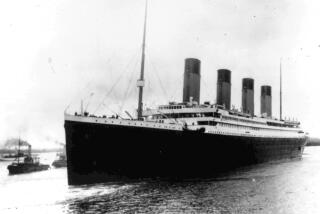Park Service Battles Over Spoils of War : Artifacts: At Antietam National Battlefield, relic hunters dig up buttons, buckles and canteens. The government wants to stop the practice.
- Share via
SHARPSBURG, Md. — The site of the U.S. military’s bloodiest battle is a battleground once more, this time over relic hunters digging up Civil War soldiers’ buttons, belt buckles and canteens.
Susan Moore, superintendent of the Antietam National Battlefield, wants to persuade landowners to restrict the use of metal detectors on the privately owned land within the battlefield’s boundaries.
“Every time you take something out of the ground, you are taking away my kids’ history,” she said. “They are removing something that could help us have a more accurate picture of what occurred here. It’s a national treasure, and it should be preserved as such.”
She said that if the National Park Service ever decides to excavate a site, the dig will meet archeological standards.
Some Civil War buffs and landowners, however, argue the artifacts will rot in the ground if not unearthed and preserved.
The Sept. 17, 1862, Battle of Antietam left more than 23,100 soldiers dead, wounded or missing. The boundaries of the 3,245-acre site include 1,400 acres of private land.
The grounds hold unmarked graves and items such as ammunition, canteens and buttons that are commanding rising prices at auctions and museums.
Moore has no control over much of the private land. Relic hunters must get permission from landowners, about a dozen in all, and some don’t allow digging on their property.
The National Park Service will soon begin contacting landowners to renegotiate the terms under which the land was incorporated into the park so that metal detectors are banned.
Richard Clem of Hagerstown, who has been relic hunting at Antietam and surrounding areas since he was a teen-ager, said the problem isn’t as bad as some believe.
“What little bit they would take, I can’t see where the park service is hurt,” Clem said. The battleground is “pretty well picked. I don’t think it’s any great problem.”
But Stephen R. Potter, an archeologist for the park service, said the depths of Antietam still have much to offer in the way of relics.
In the 1980s, Civil War buffs unearthed a grave of Confederates just 60 paces away from federally owned land at Antietam, he said. “The whole thing was ripped out of the ground,” he said.
For years, Lynn Culler’s family allowed relic hunters on their 140-acre farm where much of the heavy fighting occurred. The family sold the land in 1989 to the Conservation Fund, and it was later donated to the park service.
“Most of them were just collectors and they kept the stuff for their private collection, but there are sales and they trade things,” Culler said. “It’s going to deteriorate to nothing if they leave it in the ground.”
More to Read
Sign up for Essential California
The most important California stories and recommendations in your inbox every morning.
You may occasionally receive promotional content from the Los Angeles Times.













